|
Planting OrganicA Orchard
4
A High-Density Planting with
Scab-Resistant Cultivars
Terence L. Bradshaw, Lorraine P. Berkett, Sarah L.
Kingsley-Richards, Morgan C. Griffith
Intensive, high-density orchard
plantings have been studied since the 1960's, with
the Slender Spindle system developed in Holland and
the Vertical Axe system developed in France in the 1980's.
Each of these systems are modifications of the basic
central leader tree training system with primary changes in
trellis design, tree spacing, and shoot manipulation
being the main differences. Growers and researchers
began to realize that a tree's photosynthetic energy
could produce either wood or fruit, and that
trellises could replace much of the structural
function of strong trunks. Closely planted trees
with no large limbs, consisting almost entirely of
very productive 2-3 year-old fruiting wood borne on
a supported central leader could yield significant
quantities of high-quality fruit with excellent
light penetration into the canopy.
Extensive multi-year research in New York has shown the potential of intensive, high
density (800-1200 trees per acre) plantings in this
region. The cost associated with establishing these
plantings, including trellises, is roughly $15,000
per acre, but early returns of a few hundred bushels
per acre in year two and up to 1000 bushels per acre
by year five can potentially pay off the high, early
investment and improve economic returns over the
life of the orchard. Intensive training
systems may also serve to improve pest management in
organic orchards because tree canopies are narrow by
design, with good sunlight, air, and spray material
penetration which reduces the conditions favorable
for disease and insect pests and improves efficacy
of management materials. High density system will be a major
component of the orchard industry in years to come.
In 2011, an additional orchard (Orchard 4) to the
original 2006 OrganicA Orchards 1 and 2 was
planted at the University of Vermont Horticultural
Research Center, in South Burlington, VT. Insights
gained from management of the original organic
orchards were used in planning the new orchard.
In particular, Orchard 4 includes three important
components that differ from Orchard 1 which may
increase its horticultural performance and potential
profitability: trees in Orchard 4 are on the more
vigorous, yet still dwarfing rootstock M.26; the
orchard was planted as a high-density vertical axe
system with four feet between trees (this is more
dense than Orchard 1); and all of the eight
cultivars planted (Crimson Crisp, Crimson Gold,
Crimson Topaz, Williams Pride, Winecrisp, Querina,
Galarina, Liberty) are resistant to a major disease
of apple, apple scab, and therefore, sulfur and
lime sulfur fungicides can be eliminated along with
the non-target impacts associated with these
materials (such as reduced photosynthesis,
‘burning’ of fruit, and flaring of phytophagous mite
populations). Better tree growth and fruit yield
and quality are expected in Orchard 4 compared to
Orchard 1.
The following are the steps that were taken to plant this new
orchard, and some of the steps during first-year maintenance. This orchard will be managed using organically-accepted methods. Please note that there are other options or other techniques that can be used to plant an orchard. This publication is solely intended to be a pictorial presentation of the methods used for this particular orchard.
The new orchard was established on ground that
had been fallow since 2003 when a previous
block of apple trees was removed. Replanting apple
trees on a site where apple trees were recently
growing can lead to poor growth
from apple replant disease. Apple replant
disease is associated
with a buildup of nematodes and other microbes
in orchard soils that established trees can
tolerate, but which can lead to problems for
newly planted trees. Management techniques
include selection of tolerant rootstocks,
intensive cover cropping, or allowing the land
to lie fallow
for three or more years prior to replanting.
In this photo, the open area is the site where
Orchard 4 will be planted; Orchard 2 can be seen in
the background.
|
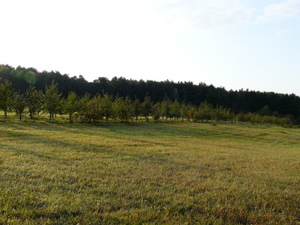 |
Spring 2010: Site Preparation
As stated above, an orchard was removed
from the site in 2003. However, in 2008, the one-acre site
was used for a different horticultural study and
was planted with ornamental shrubs which
produced edible fruit. These plants,
including most of their roots, were removed in
early spring in 2010. The rows which had been cultivated for
the ornamental shrub planting were re-used for the new orchard
and were cultivated four times in 2010 with disc
harrows to reduce weed pressure. Drive-rows were not
replanted and contain a feral mix of grasses and
broadleaf plants.
Labor time: 0.5 hr for each cultivation pass, 2 hours total |
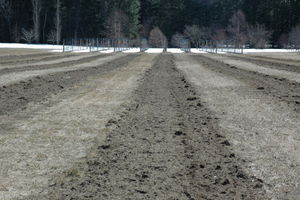
The orchard site looking north toward Orchard 1. |
March 2011: Soil Testing
It is especially important to correct any
mineral soil deficiencies prior to planting an
orchard. This helps to ensure that trees are
supplied the optimum levels of nutrients to
support early growth, and also makes
incorporation of minerals, especially calcium
and phosphorous, into the root zone much easier.
Fruit trees, like all plants, absorb most of
their required nutrients from the soil solution.
Therefore, a grower should know the nutrient
status of the soil, and apply materials to
best optimize soil nutrition. Soil samples
should be collected at least one year prior to
planting. Sites with differing topography or
tree health status should be analyzed
separately. An accredited soil testing lab can
provide specific sampling instructions for their
tests, and perform the analysis. The University
of Vermont utilizes the
Maine
Soil Testing Service and Analytical Laboratory
to conduct soil and plant tissue analyses. Other
laboratories can be found in the latest edition
of the
New England Tree Fruit Management Guide,
available from the Cooperative Extension Service
of each New England state. Most important to the
fruit grower concerning soil management should
be soil acidity and organic matter management.
Many soils in Vermont are acidic and can best
release nutrients when managed with a liming
program. Apple trees prefer a slightly acid soil
of pH
of 6.0-6.5.
Liming instructions and nutrient input
recommendations for various soil types can be
found in the Tree Fruit Guide referenced above.
It is important to check with your certifying
agent before purchasing or applying any material
to make sure it is organically acceptable.
This particular site was tested prior to planting the
previous ornamental shrub collection and thus,
the general properties of the soil were known.
Another sample was collected and tested prior to
planting in order to assess the status of the
soil at that time as well. As expected, soil pH
was in the optimum range at 6.3, and
phosphorous was not required prior to planting.
Therefore, no soil amendment additions were
made. Again, it is the grower’s responsibility
to ensure that any crop production practice or
material used in the orchard is acceptable in
their particular state’s organic certification
program.
Labor time: 0.5 hrs for
soil sample collection |

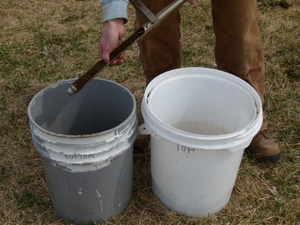
Soil test results for Orchard 4 |
April 14, 2011: Row Orientation
Given a fairly uniform plot without ledge,
excessively sloped areas, wet zones, or other
features that could impact the uniformity of the
planting, tree rows should be straight, equally
separated by the preferred drive-row width
along their length, and properly oriented to
other plantings or to maximize interception of
sunlight. In the northern hemisphere, a
north-south row orientation captures maximum
sunlight and allows for even light distribution across the
planting as the sun moves across the sky from
east to west. Where plantings are designed to line up with
existing orchards, it is helpful to maintain the
same orientation to facilitate equipment travel
and maximize land-use productivity by avoiding
narrow strips or triangles of unused land. Some
sloped plantings may require a different row
orientation to avoid crossing excessive
slopes with equipment or to minimize erosion
from rows that run straight up and down a hill.
Orchard 4 was planted to the east of
Orchard 2 and north of Orchard 1 and in-line with the rows of
Orchard 1. By using a surveyor's transit, the
rows were sited visually to match the
orientation of Orchard 1. The transit sight was
then rotated 90 degrees to determine the square
corners of the planting. From those corners, a
field tape was stretched from east to west
across the north, then south row ends, and
fifteen-foot row spacings marked and staked
within the previously cultivated weed-free
strips. Twine was stretched across the stakes to
mark the tree rows, and spots of limestone
were dropped along its length to guide equipment operation
during compost application and subsoiling
operations. The twine was then removed and
pulled to the north end of the planting
where it could later be unrolled when marking
tree holes.
Labor time: 2 hours |
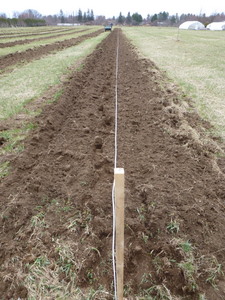 |
April 15, 2011: Subsoiling
Utilizing the
Cornell Soil Health protocol, soil quality
has been tracked in the OrganicA orchards since
2006. We observed a
restrictive hardpan
in Orchard 1 that is likely a result of regular
equipment operation during previous management
and soil preparation. Since Orchard 4 will
be just north of Orchard 1,
a single-shank subsoiler was pulled down the
tree row at a depth of 14 inches to reduce
subsurface compaction and improve water flow and
root penetration into the deep root zone in
Orchard 4,
Labor time: 0.5 hours |
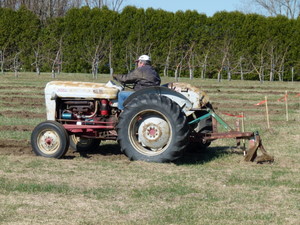 |
April 15, 2011: Compost Application
Soil organic matter is a natural source of
nutrients and also provides water and nutrient
holding capacity to light soils and increased
tilth to heavier soils. Cover crops, application
of compost, and groundcover management practices
can contribute to increasing or maintaining soil
organic matter. Generally, soil organic matter
of 2%-5% is considered good for fruit crops, with
lighter, sandier soils benefiting more from
increased organic matter.
Organic matter is naturally low in the
Adams-Windsor sandy loam soil of the orchard
site, and prior research from the University of Maine
showed improved growth for the initial three
years of an orchard's life from pre-plant
compost applied to the tree row. Thus, sixty-four
cubic yards of commercial municipal compost (Intervale
Compost Products, Burlington, VT) were applied
down the tree rows with a tractor-pulled mulch
spreader (Mill Creek Manufacturing Co.,
Lancaster, PA).
Labor time: 3 hours |
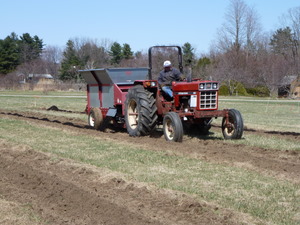 |
April 19, 2011: Compost Incorporation
Compost was then incorporated with a rototiller
to distribute evenly in the tree row and to
provide a uniform planting bed.
Labor time: 1 hour |
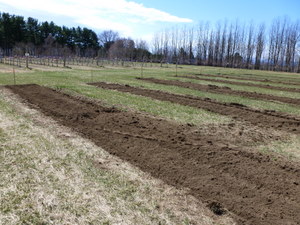 |
April 21, 2011: Marking Tree Locations
In high-density systems, the sheer number of
trees (from 726 trees per acre in this orchard
to upwards of 2000 trees per acre in Super
Spindle systems) often dictates mechanization of
tree
planting. Many growers use tractor-pulled
tree planters that open a furrow into which an
operator places a tree at a marked spot, and then
closes the furrow. The randomized
complete block design of Orchard 4,
where trees are planted in sets of eight, each
set including one each of the eight cultivars in
the planting, then repeated across the orchard,
is not conducive to such a technique. Thus,
individual tree holes were marked on a grid.
Because this is going to be a certified organic
orchard, it was important to use only approved
materials in the layout of the trees. Thus, no
paints or other prohibited substances were used
for tree marking.
Twine from row marking was pulled back down each row in a
north-south orientation. The two outside rows
were marked by stretching a measuring tape down
the row and placing a spot of lime for each tree
on a four-foot spacing. After the two outside
rows were marked, a separate line held by two
operators was stretched east-west across the
planting, lined up to the marks on each outside
row. A third person then marked each
intersection of the lines with lime until all of
the holes were marked.
Labor time: 6 hours
|
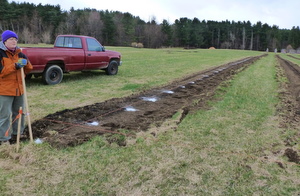
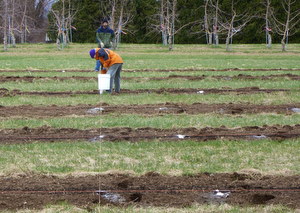
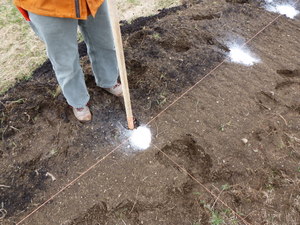 |
April 25, 2011: Augering Tree Holes
Although we opted not to use a tree planter,
with 768 trees to plant, some mechanization was
necessary. Holes were individually drilled with
a skid steer-mounted hydraulic auger with an 18"
diameter bit. Andy, our
experienced operator, augered all of the holes
in one day, then repeated the task in a separate
orchard the following day. In all, he dug 1893
holes in two days!
Labor time: 8 hours |
 |
April 26 & 27, 2011: Sorting Trees
Trees had to be sorted and their roots soaked
for 24-48 hours prior to planting. We soaked
tree roots in large stock tanks in the walk-in produce
cooler, and transferred to tanks on a trailer at planting
time. It could be easy to underestimate the time
required to sort trees, and the space they will
need to soak. We were able to fit 100 trees into
each of these 100 gallon tanks, although some of
those were a tight fit.
High density, tall spindle or slender pyramid
plantings require feathered, well-branched trees
to perform their best. The trees we planted
typically had more
than eight lateral branches and well-developed
root systems which increases the space required
for storing, shipping, and handling.
Labor time: 4 hours
|

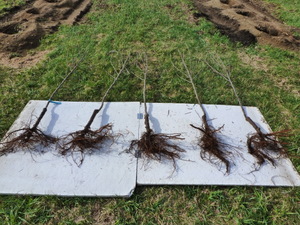 |
April 27 & 28, 2011: Planting Trees
At planting, we placed each tree in a hole
according to our randomization map. Commercial
growers would likely skip this step and plant
solid blocks or sections with each cultivar, but
it is critically important for anyone at this
step to ensure that the intended tree is going
into the correct hole. During the handling of the trees,
the roots must never be allowed to dry out.
Holes must then be backfilled and tamped to
remove any air pockets that could collapse and
allow the tree to settle. While tamping, the
tree should be pulled up to maintain its graft
union above the soil line.
All size-controlling rootstocks require that the
graft union be above the ground to prevent
rooting of the scion and loss of the dwarfing
characteristics that they provide to the tree.
Generally, the greater the amount of 'shank', or
unrooted portion of the rootstock, that is
exposed, the relatively greater dwarfing
performance that will be provided. Typically 4-6
inches of exposed rootstock is desired. This can
be difficult to do with some trees which may
have been grafted low on the rootstock, and thus
have little exposed shank. This also places the
root zone fairly high in the soil profile, so
supplemental irrigation and tree support are
needed as soon as possible.
Labor time: 42 hours (three people @ 14 hours
each)
|
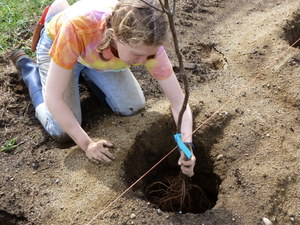
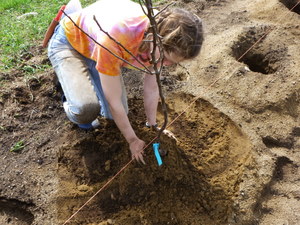
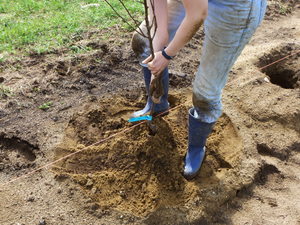
 |
|
Sometimes little feet help to get better tamping
of the soil. |
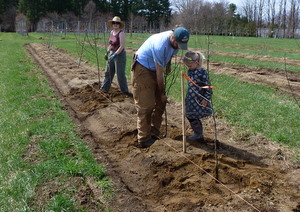 |
When well-developed trees with ample top
growth from their multiple branches are used in
high density systems, it is especially important
to monitor and provide water as they leaf out
because the leaves evapotranspire moisture that
the limited root systems cannot replace if soil
moisture becomes too dry. In most plantings, the
trees should be watered immediately after
planting, often with a tractor-pulled water tank
with side discharge nozzle. This orchard was
fortunate in that over one inch of rain fell
immediately after (and during) planting, thus
watering the trees in well.
|
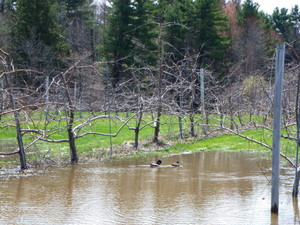
Too much water is not good !! This is a separate orchard
block on the same farm as Orchard 4. This
picture (including the ducks) was taken on the first
planting day for the new orchard. Record wet
conditions were experienced during the spring of
2011. Fortunately, the site of Orchard 4 was
not flooded. |
May 12, 2011: Trellis Construction
A primary consideration of the vertical axe
system and
other high density apple systems is that the
energy produced through photosynthesis is
directed into producing fruit rather than wood,
so large trunks are not developed to support a
developing crop. Trellising is an essential part
of this new system of apple growing. Because
this will be a certified organic planting, we
must not use prohibited materials, including
pressure-treated posts. The majority of the
posts in this orchard are steel 1.5" x 2" x 10' tree stakes
(Best Angle
, Pennsdale, PA) with
two feet buried in the soil. These stakes are
very heavy, and the angle iron construction
reduces potential for bending. They are
perforated along one side to allow for easy
attachment of trellis wires and tree training.
Stakes were set in place by one person
while a very skilled operator pushed
them into the sandy soil with a tractor bucket.
In heavier soils or with wood poles, a hydraulic
post pounder is typically used for installation.
Steel line posts were placed 32 feet apart in
the tree row.
The trellis will be a four-wire system with no
vertical poles to which to attach the trees.
This is because the expense of individual poles
with tree densities of 700-1200 or more per acre
becomes cost-prohibitive. One of the greatest
challenges to adopting these systems is in
moving away from the idea of managing individual
trees where each tree receives certain fixed
inputs (support poles, mouse guards, limb
spreaders, etc.), to thinking of the planting on
an acreage basis, and understanding the need to
minimize fixed input costs where possible.
Labor time: 5 hours
|

|
May 19, 2011: Initial Tree Training
In order to develop a dominant central leader it
is important to remove competition from lateral
shoots to encourage growth in the
primary apical shoot (the leader) on the newly growing tree.
Increased growth in the leader
is promoted by removing excess growing points immediately below the leader. Trees that do not have
their leaders stripped of side shoots below the
apical bud may grow with an excess
of vertical shoots in the top of the tree, and
areas of shootless or 'blind' wood can form
directly below those shoots. By stripping
competitive side shoots that develop 6-8 inches
below the new growth from the apical bud,
a tree with more evenly distributed side shoots
in the second year should develop.
Flowers on newly planted trees must also
be removed
for three reasons. First, the energy expended by
the tree in opening and sustaining blossoms is
better spent on developing vegetative and root
growth. Second, any fruit that set will
significantly stress the tree by serving as a
sink for water and nutrients that would be
better allocated in developing the tree itself
in the first year and their weight could stress
or break developing limbs. Finally, and probably
most important, open blossoms are potential
infection sites for
fire blight, a bacterial disease that can be
devastating to orchards, especially in their
early establishment years. The risk for fire
blight infection are increases during warm
weather, and because newly planted trees open
flower buds from one to several weeks after
established trees, the blossoms are often open
during periods of warmer weather. Thus, all
flower blossoms were removed during this and
every subsequent pass through the orchard.
Labor time: 5 hours |

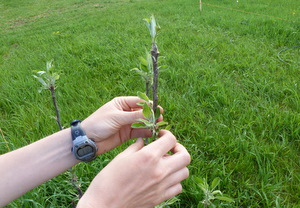 |
May 23, 2011: Setting Trellis End Posts
For this trellis system, slanted end posts were used for the row ends. This construction
design creates a very strong anchor with a
minimum of wasted space and with no specialized
components needed. Holes were drilled three feet
from the last tree in each row with a
three-point hitch auger with a 24" bit. The
12' long x 5" diameter white cedar posts were
laid out by each hole after drilling.
Labor time: 3 hours |
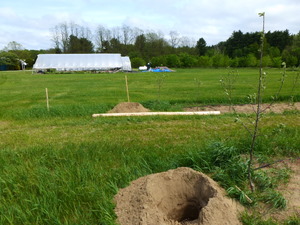 |
|
Although the Horticulture Farm is enclosed by
an eight-foot high chain link fence, deer
occasionally enter the property. We noticed some
deer browsing damage in the orchard that was
severe on some trees, but would have to be
tolerated until the culprits could be found and
removed. In some cases a fence around the
planting, if only a baited single-wire electric
one, could to be installed to deter deer feeding
damage. |
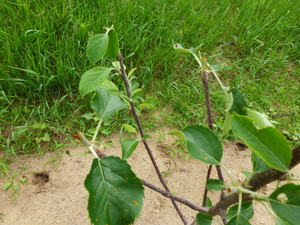 |
May 31, 2011: Irrigation
The wet weather during this planting season,
with record rainfall and historic local flooding, was not enough to meet the daily
demands of the trees at all times. An important
distinction with planting feathered trees as
opposed to traditional branchless whips is the
water requirement for the former, especially at
leaf out and early shoot growth timing. At this
time, the rapidly developing shoots and leaf
tissues require water to expand, and opening
leaves lose moisture through evapotranspiration.
The trees' root systems, however, weakened by
digging, storage, shipping, and planting, may
not have developed enough to adequately absorb
soil moisture, and thus the trees are more
prone to drought stress. We were in the process
of building our trellis at this time, and thus
the irrigation lines which were tied to existing
main lines from a previous orchard had been
pulled aside. Growers who plant high
density systems must plan ahead and have
irrigation ready the year prior to planting in
order to water trees as needed to ensure good
tree establishment. |

Wilting shoots on a newly-planted apple tree. |
June 2, 2011: Setting Trellis Posts
With the trees in the ground for over a month,
it is important to get them supported as soon as possible.
As mentioned previously, feathered trees have
large top growth compared to their root systems,
and thus need support to keep erect and to
facilitate training activities. The trellis in
this orchard will use four horizontal wires and
no vertical structures to which the trees attach. Given the large number of trees, individual
poles for each tree would be cost-prohibitive, with electrical
conduit costing over $3.00 per tree and cheaper
bamboo prone to breakage. Some growers have used
wires tied vertically from the top to the bottom
wire to provide a training support, but the
labor for such a system seemed excessive.
Trellis poles include the previously driven
steel posts with a single vertical wood pole for
increased support in the middle of the row and a
slanted back brace at each end. Organic regulations preclude
the use of pressure-treated lumber for trellis
construction. Locally-sourced white cedar was
used due to its relative rot resistance, low
cost, local availability, and uniform quality.
Poles were 6 inch diameter and ten feet long.
The slanted end brace posts were installed in the 24"
drilled holes that had been cleaned out on the
treeline-side with a shovel to allow for deeper
anchorage of the post bottom against undisturbed
soil. Slanted posts are a preferred anchor
technique because the top trellis wire, which is
tied to the base of a short end post and is run
up over the top of the trellis post, pulls the
slanted post into the soil with increasing
canopy weight or wire tension. A cinder block
was inserted behind the pole to stabilize it in
the hole, then the pole adjusted to the desired
angle, backfilled, and then the soil firmly tamped. Slanted end posts
can be set using a protractor to sight the
desired angle for the two outer rows, then
middle poles set by visually lining up to the
end rows. When a wire is stretched from the
short anchor post (installation discussed below)
and up over the slanted end post, the pole, wire, and soil line
should ideally form an equilateral triangle.
Labor time: 7.5 hours
|
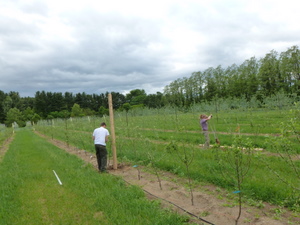
Setting out trellis posts.
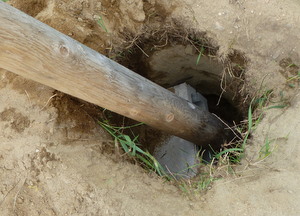
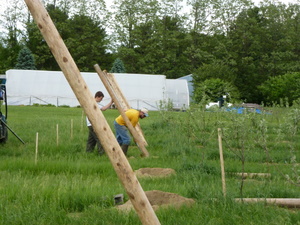 |
June 3, 2011: Setting End Anchor Posts
End anchor posts are an especially critical part
of the trellis construction, since they
ultimately support the entire weight of the row.
We used six inch diameter, six foot-long posts
driven four feet into the ground. A post pounder
was available that could drive these shorter
poles positioned at the ends of the rows, as opposed to the longer poles
used in the rest of the trellis which were
placed in dug holes. This implement uses tractor
hydraulics to position the post channel and
pounding head, and to lift the head into
position. The head is dropped by gravity, then
lifted again hydraulically and repeated until
the post is driven to the desired depth. Post
driving only takes a minute or two, but
positioning the post takes a bit more time.
In total, each 384-foot orchard row required two
anchor posts, two slanted end posts, a single
vertical wood post in the center of the row, and
ten steel line posts to complete the trellis.
Labor time: 3 hours |
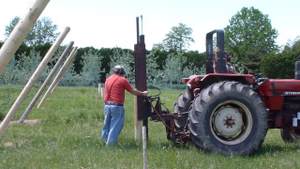 |
June 6, 2011: Pulling Trellis Wire
Now that all of the trellis posts have been set,
it is time to pull wire. In a vertical axe
planting, the trees are not allowed to grow
thick trunks, yet they are encouraged to fruit
heavily. Thus, the full weight of the crop must
be borne on the trellis, so skimping on trellis
materials or construction in the first year is
not recommended.
High tensile 12 ga wire was used for all lines.
Wires were pulled out along each row and hand
tightened, then crimped. It is especially
important to use wire, crimps, and tools
designed for trellises, since many types of
basic fencing wire cannot handle the unique
stresses of orchard trellises.
For this planting we used four wires spaced
roughly at 18", 42", 66", and 90"
from the soil surface. The
bottom wire height was set to hold the
irrigation lines which would be closely suspended on
them, keeping them
out of the way of cultivators and other orchard
equipment. This prevents dripping water onto
foliage and thus reduces potential disease risk.
A larger gap was allowed between the first and
second wires in order to allow workers to cross
the trellis, at least before the trees
completely fill their space.
At the ends of each row, wires were passed through a single hole drilled
through the back anchor post, then wrapped and
crimped, making a very secure connection.
Labor time: 15 hours |
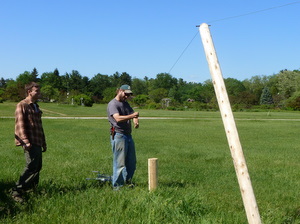
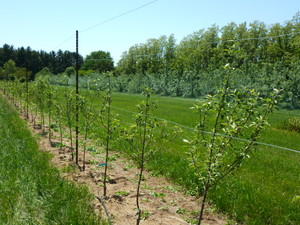
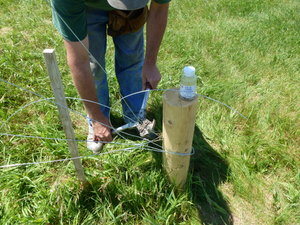
 |
June 10, 2011: Tensioning Trellis Wires
Wires were now tensioned using inline strainers
and a tensioning handle. These strainers allow
for subsequent adjustment of wire tension, and
can be installed after wires have been pulled.
It is important to tighten wires as much as
possible at the initial installation, especially
when using the tree clips shown. Loose or broken
wires can grab clips on wires below and, when
tensioning, pull the clips upwards which can
damage the trunk or limbs or even uproot a
newly-planted tree.
Wire trellis clips were used to tie the trees to
the trellis wires. These clips lock onto the
wire and do not slide horizontally while
allowing a tree room to grow. The largest clips
are used on the lower trunk, while the upper
section has smaller clips. The trees cannot
be allowed to grow larger than the clips or
girdling will occur, but under this high-density
system, thick trunks do not develop.
Labor time: 1.5 hours |

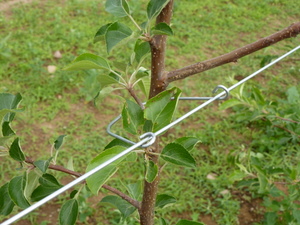
|
June 16, 2011: Weeding
In-row weeds had not yet been managed in the
planting, so a pass with the hydraulically
operated Weed Badger was made. This tool, while
very effective in maintaining good weed control,
requires very careful operator attention. In
this pass, three trees were very quickly
destroyed by contact with the rotating tines
of the cultivator. In order to minimize tree
damage and detrimental soil health effects from
cultivation, we are planning to use mulch to
manage weeds in this orchard, but a clean,
relatively weed-free surface was needed on which
to apply the mulch.
Labor time: 0.5 hours |
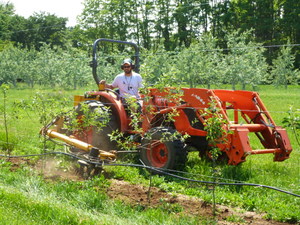 |
June 20, 2011: Tree Training
Possibly the most important component to high
density apple plantings is
early tree training. A commonly asked
question is "Won't the trees grow together?" To
some degree they will, but excess vegetative
growth on branches is minimized by manipulating
them to change the hormone flow in the branch
and both discourage growth directly as well as
encourage the development of fruiting buds. A
precocious tree that sets fruit early and
maintains that production annually will settle
into maturity early, and thus maintain a
desirable balance of vegetative to fruiting
growth.
Just as we removed competing shoots below the
central leader earlier in the season to
encourage apical dominance in the upper section
of the tree, and thus reach our desired height
within three years, we manipulate auxin but in a
different way elsewhere in the tree where the
desired canopy structure and branching have
developed. Lower limbs, or 'feathers', which were
on the tree at planting are bent below
horizontal to interrupt the flow of auxin, a
plant hormone generated in apical growing
points. The reduction in auxin concentration in
adventitious buds on these branches encourages
the development of fruit spurs and buds that may
become next year's fruit.
Many training tools can be used to achieve this
branch bending including strings, toothpicks, wires, or the rubber bands shown
here. Cost for each training tool is a primary
consideration when eight or more branches per
tree may be spread, with upwards of 1000 trees
per acre in a planting. In this orchard, the
difference between a $0.10 wire spreader and a
$0.01 rubber band is $720! Other downsides
to some spreading tools include the learning
curve in using them, excessive time
requirements, less desirable shoot positioning,
and possible shoot breakage during or after
installation.
These rubber bands required 12 hours of labor to
install in the one-acre orchard. Some shoots were
damaged during training, but the speed of
completing the task seems to have been worth it.
Roughly 6600 (7.5 bags) of bands were used at a
material cost of $78.75
Labor time: 12 hours |

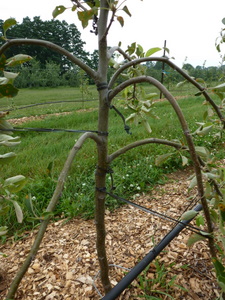 |
June 24, 2011: Mulching
Over the six seasons of managing OrganicA
Orchard 1, we have used multiple strategies for
management of in-row groundcover beneath the
tree canopy. Because of the naturally low
organic matter content of our soil, we are
interested not only in reducing competition for
water and nutrients from weeds, but also in
increasing the organic matter content,
the biological activity, and the moisture retention
properties of the soil.
After cultivating under the trees previously in
the season to establish a clean strip, we
applied whole-tree wood chip mulch to the
rows. The material was spread with an
automated side-delivery mulch wagon, which
greatly saves on labor compared to hand
application. For this application, 90 cubic
yards of mulch were applied in 1.5 hours.
Mulching to this degree is only economically
feasible if a source of inexpensive, high-quality chips is available. We
contract with a local tree service for
whole-tree chippings of hardwood species. Most
chips are from low-grade trees (poplar, boxelder,
birch) with some more valuable species such as
oak and maple chipped from the tops after logs
have been cut. By working with a tree service as
opposed to using 'landscape quality', i.e.
uniform, primarily bark mulch, we can cut our
material costs from roughly $30 per yard for the
landscape material to $5 per yard for the
whole-tree chippings.
Although weeds, especially quackgrass, will grow
in the mulch, their roots rarely extend far into
the root zone of the tree, and they can more
easily be pulled from the mulch than from the
soil itself. The use of electronic moisture
monitors in Orchards 1 and 2
consistently show better moisture retention and
less need for irrigation in the mulched Orchard
1 than in Orchard 2, which is grown in sod
cover.
Labor time: 1.5 hours |
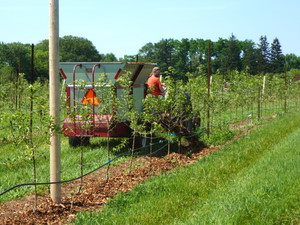
 |
July 14, 2011: Surpirise!
We were especially surprised, and not in a good
way, to find extensive apple scab incidence on
what we thought were
Nova Spy trees in the planting. The premise for
this orchard is that the use of apple
scab-resistant cultivars will allow us to reduce
potentially phytotoxic fungicide sprays and achieve better
growth and yield under organic conditions
compared to scab-susceptible cultivars. The presence of
apple scab in this orchard was a shock, since
this would suggest the presence of a
race of the pathogen capable of causing
infection on cultivars considered resistant
based on the Vf gene in their breeding
background. However, we quickly contacted the
nursery and confirmed that we did not receive
Nova Spy, but rather Rome Beauty, a cultivar
that is susceptible to the apple scab races
found in North America. Rome does not grow
especially well in the Champlain Valley of
Vermont, and have low fruit quality for the
fresh market, so we pulled
the trees out to maintain a true scab-resistant
orchard and no effort was made to save the trees
for another plot at farm. In the picture on
the left, a 'Weed Wrench', which grips woody
brush by the base and pulls it up, roots and
all, is being used to pull out a Rome Beauty
tree. In 2012, Liberty trees will be planted in
the empty spaces.
Labor time: 1 hour
|

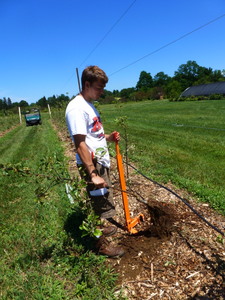 |
July 29, 2011
Fire Blight Assessment
During routine assessment for fire blight in the
other orchards, some symptoms were found in the
orchard adjacent to Orchard 4. Because fire blight
can be so damaging to young trees, and allowance
of the antibiotic Streptomycin is set to expire
under National Organic Standards, we know we
need to be extra vigilant in scouting and
removing potentially diseased tissue. In walking
through
the new orchard, a number of shoots were observed that
were dying back and possibly could have been
infected by the fire blight bacteria. Luckily,
most shoots were damaged by some other cause. In
many cases, shoot tips were broken during tree
training or girdled by the rubber bands used to
position shoots. In some instances, rust or
possibly nectria
canker lesions were observed at the base of dead
spurs or shoots that appeared to have choked out
the growing tissue. While of concern and
requiring a management strategy in the future,
the lesions are caused by fungal pathogens which
are not as potentially damaging as a fire blight
outbreak. |
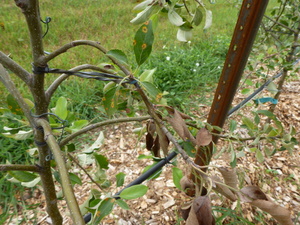
 |
November 8, 2011
Installing Vole Protection
After the extensive work involved with planting
the trees, building the trellis, and early tree
training, the orchard was simply allowed to grow
for the rest of the summer. Trees began to drop
their leaves in early November, and would be
dormant soon. In preparation for winter, spiral
plastic vole guards were installed on each tree.
At a cost of $1.05 each, these are an expensive
addition to the orchard, but vole damage on
trees in an adjacent orchard in spring 2011
convinced us that the expense was worthwhile.
Voles are active year-round, and feed on plant
tissues under the snow line in winter. Excessive
feeding on trunk bark and cambium tissue can
girdle trees and kill them in one season. Spiral
guards must be removed during the growing season
to allow trunks to dry out and to expose
potential trunk-boring insects to natural predators. Therefore, this will be an
annual expenditure of labor until the trees are
well-established and develop a thick bark on the
trunk that may resist vole feeding.
Labor time: 4 hours |
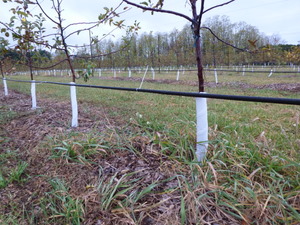 |
|
|
|
|